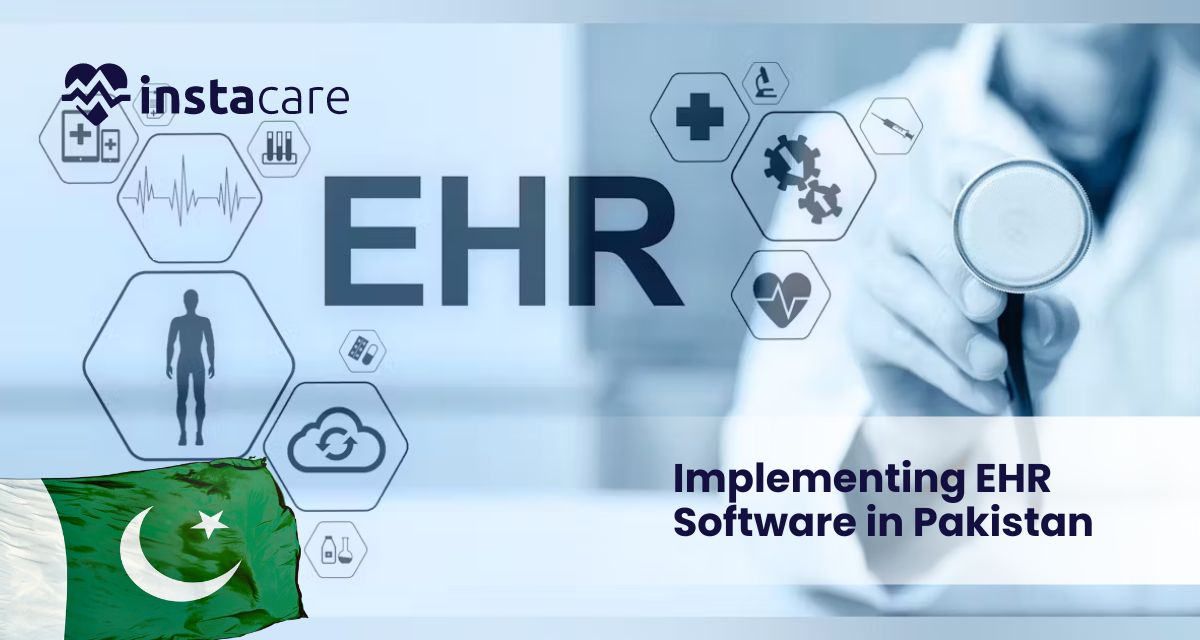Last updated on Friday, 11, October, 2024
The Implementation of EHR Software has brought a sea change in the healthcare landscape around the world. With the implementation of EHR systems in Pakistan, patient care will be enhanced and operations streamlined with efficient data management at healthcare facilities. However, the journey towards successful implementation is challenging and hostile. This article discusses several drawbacks faced by healthcare providers during the EHR system adoption process, strategies to overcome these drawbacks, and practical solutions for achieving successful implementation.
Table of Contents
Definition of EHR Software
EHR software is an electronic version of a patient’s chart that provides an individual with the complete information involving the medical care of a patient, diagnosis, drugs, treatment and medication plans, dates of immunization, allergies, radiology images, and laboratory test results. With EHRs, health care settings may be shared, and there can be better coordination and continuity of care than in traditional paper records.
Benefits of EHR Systems
- What precedes the discussion of the challenges of EHR systems is the benefits that accrue from their use. These include:
- Improving Patient Care: Access by healthcare providers to instantaneous patient data can improve clinical decisions made about a patient’s care and subsequently impact outcomes.
- Efficiency: EHRs remove most of the administrative workload in healthcare settings by reducing paperwork and making workflow more efficient.
- Data Analytics: EHRs facilitate data analytics, and by doing so, healthcare service providers can derive information in respect of patient populations, treatment results, and operational efficiencies.
Regulatory Compliance: EHRs can ensure that the healthcare organizations meet their regulatory requirements in the form of maintaining patient records with maximum precision.
However, on the other side, EHR software implementation in Pakistan has its own difficulties.
Challenges in Implementing EHR Software
1-Infrastructure
One of the many bottlenecks within EHR implementation in Pakistan is low-level robust IT infrastructure. Most healthcare centers lack hardware, appropriate software, and internet connectivity to support EHR systems, especially in rural areas.
Solution:
To mitigate this challenge, the government and the private sector need to be willing to spend on IT infrastructure. This includes high-speed internet access, investment in modern hardware, and ensuring that software solutions are compatible with existing systems. Setting up partnerships with the technology companies can also do this.
2-Resistance to Change
Healthcare professionals have a reputation as being notorious change resistors. In addition, change is often linked to technology. All these factors can pose a threat: from the lack of understanding of EHR systems to any fear of the unknown or real concerns over one’s job.
Solution:
To overcome resistance, it is the responsibility of health care organizations to prepare significant training programs for their staff members to educate them about the merits of EHR systems. Training programs must concentrate on actual practice so that healthcare professionals become accustomed to the technology. In addition, including the employees in decision-making and involving them in an activity to address their fears helps to create a culture of acceptance.
3-Data Privacy and Security Concerns
This is also likely to raise quite a number of concerns over data privacy and security in digitized patient records. When cybercrimes are on the rise in Pakistan, healthcare providers must ensure that EHR systems adhere to data protection regulations and secure information for patients.
Solution:
Strong security measures must be in place in order to protect the patient’s data. For example, encryption, access controls, and regular security audits are part of the overall package. In addition, health care providers must educate workers about best practices on data privacy and why confidential information must be protected. Collaboration with cybersecurity experts will help organizations stay ahead of the emerging threats.
4-High Implementation Costs
Such a thing may even prove quite expensive to implement for smaller healthcare facilities since implementing EHR software can be very costly. These costs include the amount charged for software licenses, hardware acquisition, training, and maintenance support.
Solution:
The financial pressure can be reduced by acquiring government programs or NGOs’ aid. Health care organizations can also partner with the vendors in technology so as to have more discounted rates or accommodation terms. Introducing EHR systems in a phased implementation manner allows the spreading of the costs over time.
5-Interoperability Issues
It refers to the ability of disparate EHR systems to communicate and share information with each other. In Pakistan, many healthcare facilities have disparate systems that are unlikely to be compatible with one another, hence fragmented patient information.
Solution:
In consideration of interoperability, the government should make an effort to establish standards for EHR systems in Pakistan. Encouragement to vendors to take on the standards should ensure data shared between all different health care facilities with no interoperability issues present. Additionally, embracing open-source EHR solutions will support interoperability.
6-Limited Awareness and Understanding
Not many people, including health care providers, in Pakistan know about the EHR system, its functions, and advantages. This can also be a barrier to the full adoption of EHR technology.
Solution:
Educating healthcare providers as to how EHR systems benefit their patient care is a good strategy; ideally, this should begin with awareness campaigns that healthcare organizations can conduct. Tapping into medical associations and conducting workshops or seminars can sensitize more healthcare providers towards the adoption of EHR systems.
7-Cultural and Linguistic Barriers
Pakistan is a multi-linguistic country with diverse cultural practices. The adopted EHR systems, if not aligned to the local context, may face difficulties.
Solution:
EHR software needs localization so that different languages and cultural practices could be incorporated within the software. It will also ensure that the local healthcare providers are engaged in the development process so that a system will be delivered that takes care of the needs of those Pakistani healthcare providers.
8-Data Migration Problems
Migration of the existing paper records to EHR: This is a laborious process. There are chances of some entry error, incompleteness, and voluminous information that needs digitizing.
Solution:
Phased data migration can minimize the complexities involved in such a process. It would be more beneficial for healthcare providers to maintain patient information at the core and transfer them in increments over time. Having data entry services or temporary staff handle this for you can also smoothen the process.
9-Limited Technical Support
After deploying EHR systems, healthcare providers can experience technical issues that should be addressed immediately. The lack of readily available technical support may exacerbate frustration and poor use of the software.
Solution:
Healthcare organizations should create defined channels for support like a helpline and on-site support. Collaborate with EHR vendors for after sale support services to ensure prompt response to technical issues.
10-Compliance Related Issues
It is even harder to maneuver the needs for their regulation as they vary with time. Healthcare providers should ensure that the systems are in a state that is compliant with the laws and regulations on the local level. It changes with time.
Solution:
The healthcare providers can stay abreast of the changing regulatory requirements through the regular compliance audits. There are experts in the law with whom close liaison exists pertaining to health regulation. Thus, working with them can be very instrumental in providing a guide to ensure EHR systems meet all the standards.
Conclusion
There are a number of challenges this would bring along in implementing EHR software in Pakistan, but with proper measures, it can surely pave its way out from those challenges to benefit from digital health records. Investing infrastructure, training the staff on EHR through comprehensive programs, data safety, and awareness are sure steps toward the future for the healthcare sector-a better and effective tomorrow.
FAQs
1-What is an EHR system, and why is it important for healthcare providers in Pakistan?
A fully characterized EHR is a digital version of any patient’s paper chart, encompassing all of the key administrative, demographic, and clinical data relevant to that particular patient’s care under a single record located in one place. It is an important requirement for healthcare providers in Pakistan because it would enhance the high quality of patients’ care, reduce operations-related problems, and improve data management in the organization.
2-What are the primary problems of healthcare providers in implementing EHR systems in Pakistan?
Its main challenges include a lack of infrastructure, resistance to change, data privacy and security concerns, high implementation cost, interoperability issues, lack of awareness, cultural barriers, challenges in migrating data, limited technical support, and regulatory compliance.
3-How do healthcare providers overcome the challenges associated with EHR implementation?
Such providers can overcome the challenges by investing their infrastructure. There has to be comprehensive training among the healthcare providers. They should implement robust security measures. It also requires financial assistance, creating awareness, and setting up support channels for continued support. With routine audits and phase data migration, it becomes much easier to transition to EHR systems.



